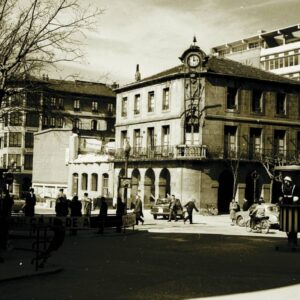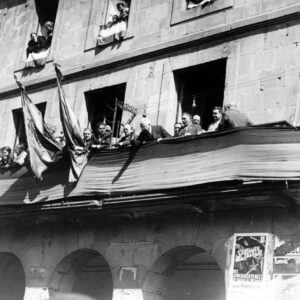Description of events
Date :
Address : Herriko Plaza 1
During the Republic, the Barakaldo Town Hall was located just in front of the current one (inaugurated in 1962), in a building built in 1891, replacing the old town hall that was next to the church of San Vicente.
The site it occupied was known as Rájeta, hence the school that also housed the new building – which was also the headquarters of the municipal headquarters – was known as Rájeta schools. The new city hall building had been erected next to the Herriko Plaza, which during the Republic would be renamed, precisely, Plaza de la República.
The elections of April 12, 1931 in Barakaldo offered a majority result to the anti-monarchical forces, as happened in a good part of the State.
The results were the following (Aizpuru, vol I, p.222):
– Radical Republican Party: 8 councilors.
– Socialist Party: 8 councilors.
Basque Nationalist Action: 5 councilors.
– Basque Nationalist Party: 4 councilors.
– Independent Catholics: 4.
Simón Beltrán Moreno, of the Radical Republican Party, was appointed mayor.
The victory of the Popular Front in February 1936 caused the municipal corporations of 1931 to be restored. Beltrán Moreno was dismissed and the socialist Eustaquio Cañas was provisionally appointed mayor-president on March 12, 1936, who would remain in office until the fall of the Anteiglesia into Francoist hands. It was this new corporation that had to make numerous decisions to deal with the fateful days of the Civil War, in a population that at that time already had some 35,000 inhabitants.
One of those first decisions, following the indications of the legitimate government, was the constitution of the Committee for the Defense of the Republic, made up of several parties and unions that had spoken out against the uprising. It was made up of representatives of the Socialist Party, Republican Left, PNV, UGT, CNT, STV, Republican Union, Communist Party, ANV and Autonomous ANV.
Likewise, a notice will be published for the requisition of arms and ammunition between companies and individuals. During the time that the war lasted in Barakaldo, the consistory maintained order in the streets of the town at all times.
The city council actively collaborated with the measures adopted by the Government of Euzkadi.
At all times, the city council was loyal to the legitimate government of the Republic. The municipal archive of Barakaldo preserves a telegram from January 1937 from Francisco Largo Caballero, at that time president of the Council of Ministers and Minister of War, thanking a previous telegram in which the Barakaldo City Council showed its adherence to the republican government in Valencia .
“I acknowledge receipt of your telegram addressed on behalf of the City Council, thanking you sincerely for your enthusiastic offer and unconditional adhesion. On behalf of the government, I correspond to your warm and cordial greetings. Long Knight ”.
In those months that the war in Barakaldo lasted, the city council developed a frantic work since, together with its own powers, it also assumed those that were derived from the war conflict: care for refugees and evacuated by the bombings, coordination together with the Government of Euzkadi from the network of blood hospitals, coordination with the battalions stationed in the municipality, supply of basic necessities, etc.
On June 22, 1937, Franco’s troops took Barakaldo.
Days later, José María Llaneza Zabala would be appointed mayor. A new stage began for the Barakaldo city council in the hands of the Franco regime.
SOURCES :
AIZPURU, Mikel (2010). Barakaldo, an industrial city: boom and consolidation (1900-1937). Vol. I. Bilbao: Beta III Milenio, DL
Place reference
During the Republic, the Barakaldo City Council was located right in front of the current one (inaugurated in 1962).
Where is the SAT
State of conservation
It is currently part of the town hall.








